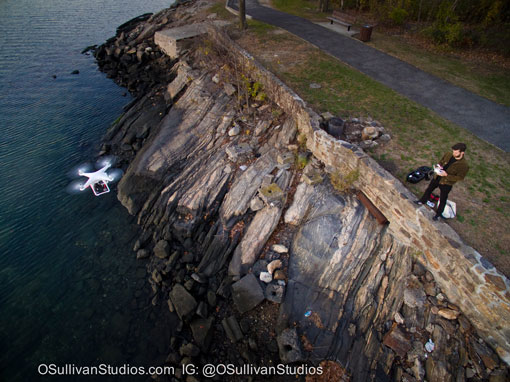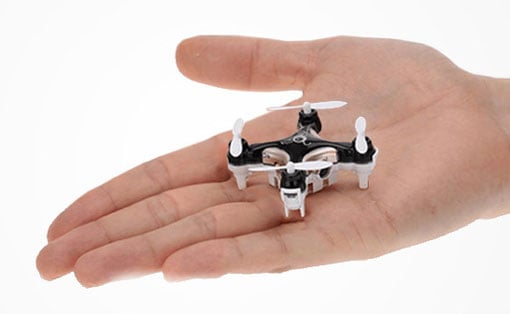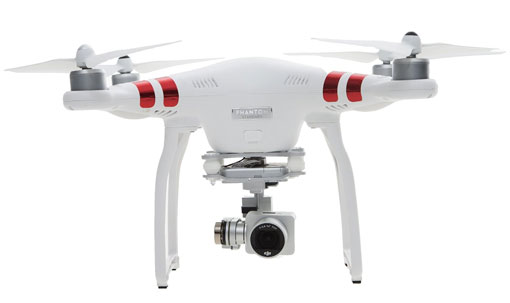
John O'Sullivan of O'Sullivan Studios takes a selfie with his drone.
Drones are “the next big thing” for hobbyists, as they quite literally and figuratively take off. Once limited to professional use for tasks like military covert operations and firefighting, unmanned aerial vehicles (UAV) are now being produced at prices that bring them into the reach of the everyday enthusiast, and are becoming increasingly popular for recreational use.
The Consumer Technology Association expects “the U.S. market will approach 105-million-dollars in revenue in 2015 (increasing by more than 52 percent from 2014) with unit sales expected to approach 700,000, an increase of 63 percent,” says Laura Hubbard, Senior Manager of Industry Communications for the Association. And research forecasts from the group say the global market for drones could reach 300-million-dollars by the year 2018.
You can see why drone sales are exploding from the beautiful video by O'Sullivan Studios, which showcases the power of drone aerial photography to transform the everyday into something special.
However, the outlook for drones is not entirely rosy. Recreational drones are making headlines for creating airport hazards, interfering with emergency services and endangering people’s lives. And in order to keep better tabs on all of these new unmanned aircraft, the U.S. Federal Aviation Administration (FAA) is now requiring owners register their drones.
So what should you know before buying a drone? We talked to industry experts and pros that use drones to find out.
What Type of Drone Should You Purchase?
Steve Cohen, an Educator at Bergen County, New Jersey Technical Schools, Applied Technology High School, advises novices to buy a Micro Drone first. That’s a drone that can essentially fit in your palm or pocket. You can test it inside your home and you can easily find models for less than 100 dollars.
Cohen explains, “The micro-drones are not suitable for outdoor flight—they are purely intended for operators to become more proficient in operating drones. Once you get into the $600 price point and a weight range of 2-4 pounds (with safety features like geo-fencing and return to home), you can start taking your aircraft to higher altitudes.”
The controls for micro-drones are basically the same as larger drones, however you are likely not getting the safety features and other bells and whistles, which can include GPS and video downlinks to tablets and smartphones.
“Learning to work with a smaller drone will help you man a larger, more expensive and more fully featured complex model,” adds Cohen.

The Cheerson CX-10c weighs just 0.53 ounces and takes 0.3MP pictures
and SD video.
For example, you could start off purchasing this inexpensive and tiny 0.53-ounce Cheerson CX-10c ($34.99 on techlicious.com) with a flight time of about 4 minutes and an SD (0.3MP) onboard camera or the 0.53-ounce Hubsan H107C+ HD ($89.99 on techlicious.com) with a flight time of about 7 minutes and an onboard HD camera. Neither of these drones require registration.

The DJI Phantom 3 Standard flies for 25 minutes, weighs 2.68 pounds
and records HD video.
Once you’ve established your comfort level and worked on your flying ability, you may then want to consider options in larger sizes and price tags. For instance, the medium-sized 2.68-pound DJI Phantom 3 Standard ($499 on Amazon) has a flying time of up to 25 minutes and an on-board, stabilized camera that can stream HD video back to the operator and take 12MP stills. The 3.3-pound 3DR Solo Drone Quadcopter ($999 on Amazon) has a flying time of up to 25 minutes and advanced operational features like follow me, orbit (for circling an object), selfie (for keeping you in the picture as it flies) and safety net, which ensures your drone stays below the maximum height allowed by the FAA (400 feet). You'll need to supply your own compatible GoPro HERO3+ ($227.15 on Amazon) or HERO4 (starting at $199.99 on Amazon) action camera.
In general, the more expensive, larger drones are tooled with everything from 3-D mapping and videography to search and rescue maps. The good news is that while larger, heavier and more technical, they can be easier to operate.
Recently, manufacturers, including DJI and 3DR, have started work on integrating maps into drones that can be updated in real time with no-fly zones, allowing for geo-fencing and the creation of virtual boundaries. So if there were an emergency, drone operators would know how to avoid temporary no-fly zones.
Do You Need to Register Your Drone?
As of December 21, 2015, owners of a drone weighing more than 0.55 pounds and less than 55 pounds, including accessories like on-board cameras, must register their drone with the FAA. To register, you must be 13 years of age or older and a U.S. citizen or legal permanent resident. It costs just $5 and registrations entered before midnight EST on January 21, 2016 will be refunded.
What You Need to Know Before You Fly
While they may look easy to fly, even the smallest of drones are potentially much more than mere toys. While one can learn the techniques with an inexpensive micro-drone, experts suggest that you get trained and educated in the craft before taking one out in the field.
“Go to a group like Drone User Group or the Academy of Model Aeronautics to seek out clubs and forums,” advises Cohen.
The Consumer Technology Association ’s emphasizes the importance of the FAA and industry guidance and encourages users to review this check-list of tips for safe recreational use of drones before they start flying them including:
- Operate the device under specific safety guidelines established under federal, state, and local regulations. Check out KnowBeforeYouFly.com an educational campaign and website established to help you to learn drone specs, requirements and guidelines for your area by plugging your zip code into their locator.
- If you’re flying a drone within five miles of an airport, be sure to notify the airport or control tower before you begin flying your drone.
- To avoid other air traffic, your drone should fly no higher than 400 feet above the ground. Always keep your unmanned aircraft within eyesight, and use an observer to assist if needed.
- Avoid intentionally flying over unprotected persons or moving vehicles, and keep your unmanned aircraft at least 25 feet away from individuals and vulnerable property.
- Sensitive infrastructure or property such as airports, power stations, water treatment facilities, correctional facilities, heavily traveled roadways, government facilities, stadiums, etc. should be avoided as places to fly your drone.
- Remain well clear of - and do not interfere with - manned aircraft operations. You must observe and avoid other aircraft and obstacles at all times.
- Adverse weather conditions such as high winds or reduced visibility will impact your ability to manage your aircraft.
- Don’t conduct surveillance or take pictures of people in areas where there’s an expectation of privacy. Be respectful and considerate of privacy concerns in the areas where you fly.
The FAA offers its latest guidance on its website.
What Happens If You Enter a No-Fly Zone While Using Your Drone?
Visit KnowBeforeYouFly.com before launching your drone. Breaking the rules could result in a citation, community service and/or probation plus confiscation of your drone and all the accompanying equipment. If the offense is larger (such as hurting a pedestrian or destroying public property) the punishment could be much more serious. So respect the guidelines, play safe and have fun with your new hobby!
[Image credits: O'Sullivan Studios, Cheerson, DJI]
















From g_ro on January 19, 2016 :: 1:20 pm
Nice article on the introduction to drones. I especially love the video.
Reply